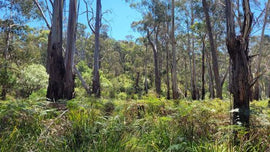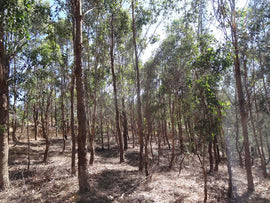Witzend is located about an hour and a half north east of Byron Bay and just south of the World Heritage-listed Border Ranges National Park. Following our planting here in 2018 and 2019, there are now more than 13,000 native trees growing on the site.
While this property has been impacted by grazing in the past, a significant area had already been restored prior to Greenfleet’s work. We are collaborating with the landowners to restore the native forest and support the unique biodiversity of the region. As a result of this, habitat restoration will be one of the main ongoing benefits of the project at Witzend.
Habitat will be extended for koalas, which are considered vulnerable in the area and whose population in NSW has been heavily impacted by the 2019 fires. There are also a number of other species that are classified as vulnerable or endangered that can utilise the trees. The Spotted-tail Quoll (Dasyurus maculatus), Red-legged Pademelon (Thyogale stigmatica) and Albert’s Lyrebird (Menura alberti) are all considered vulnerable in the Horseshoe Creek (pictured) area.
Additionally, the Brush-tailed Rock Wallaby (Petrogale pencillata), Loveridge’s Frog (Philoria loveridgei) and Double-eyed Fig Parrot (Cyclopsitta diophthalma coxeni) are some of the endangered species known to the region. As these native trees grow, we hope to see them provide homes for these animals so that some of these species can return.
When it comes to planting, there are multiple methods that we use at Greenfleet but the trees at Witzend were planted as seedlings. We planted a mix of more than 20 native species to create a biodiverse ecosystem. From smaller trees like Black Tea Tree (Melaleuca bracteate) to towering giants like Forest Red Gum (Eucalyptus tereticornis), the selected trees will grow into a biodiverse forest.
In July 2020 we returned to the property to plant even more trees, including Forest Sheoak (Allocasuarina torulosa) to provide potential habitat for the area’s endangered Glossy Black Cockatoo (Calyptorhynchus lathami) population.
You can join the fight against climate change and offset your emissions through our native reforestation projects such as this one, click here.

Location Size
Planting Dates
Species
- Araucaria cunninghamiana
- Castanospermum australe
- Eucalyptus microcorys
- Eucalyptus tereticornis
- Flindersia xanthoxyla
- Lophostemon confertus
- Podocarpus elatus
- Casurina cunninghamiana
- Commersonia bartramia
- Grevillia robusta
- Lophostemon suaveolens
- Melaleuca stypheloides
- Melaleuca quinquinervia
- Syzygium australe
- Callistemon viminalis
- Ficus coronata
- Guioia semiglauca
- Hymenosporum flavum
- Melaleuca bracteata
- Melia azedarach
- Pittosporum undulatum




